
How To Sell Art Online: The Ultimate Guide For 2023
If you’re an art graduate you’re most likely well-versed in important concepts like brush techniques and composition, but you may know very little about business, how to make money from your art, where to sell it and how to build a personal brand.
Having a career as an artist isn’t just about your work, but building an audience around your work, and establishing a sufficient process by which you can package your and charge money for it. In short, it’s not just enough to be an artist. You also have to be an entrepreneur.
In the pre-internet days – or at least before the advent of ecommerce platforms – artists mainly relied on agents, gallerists, or retailers to distribute work, and did not have the convenient resources we have at our fingertips today.
In the modern art world, artists now have full control over the creation of their art, the selling of their art, and the creation of distribution streams. These are all significant advances, but often the choice is overwhelming.
After all, where do you even start?
There are a wide variety of platforms available to independent artists who wish to sell their art online, and setting up your own online store is also an option. So whether you’re a graphic designer, professional photographer, avant-garde artist or a curator of art this article is for you.
Below, you’ll find detailed, practical advice on how to sell your art online, as well as how to build your brand, package your art, and even how to avoid plagiarism.
Is It Worth Selling Art Online?
Let’s take a look at the advantages and disadvantages of selling your art online, or signing up to an online gallery.
Broaden Your Reach
The world is your oyster when it comes to selling art online. Literally! Selling your art online means broadcasting your work to people all over the world, giving you the opportunity to reach a whole new audience.
The online market lets buyers who may feel reluctant buying art in a physical gallery to instead buy it in a setting they’re more comfortable with – i.e. online.
With online galleries, buyers can now curate a collection of art from the comfort of their home. This gives artists an opportunity a chance to tap into a whole new group of art buyers.
You Don’t Have To Do The Marketing
Selling art on your own website is a daily grind. You have to promote your art on social media platforms like Instagram, Twitter, and Facebook. You may have to create a blog and write a weekly or monthly newsletter to keep potential buyers hooked.
However, some online art galleries have millions of dollars at their disposal which they use to boost traffic to your art. Although they also represent hundreds of other artists, a successful online art gallery can open up your work to interested buyers without you having to do a thing.
A Good Supplement To Your Income
We all know that making a living as an artist isn’t easy, even seasoned artists may find it difficult to maintain an income that is consistent month by month. But selling reproductions of your art online can be a good supplement to your income.
The commission you receive from an online gallery is usually a lot lower than a physical gallery. It can range from 1-5% on the lower end of the scale, and 10% on the higher end. Online galleries are able to do this because they have lower overhead costs.
Still, if you are selling your art via galleries, it’s important not to undersell them. It’s crucial to maintain good relationships with whoever is selling your art.
You Lose Out On Personal Connections
When an online gallery is handling the sale of your art, you miss out on the chance to forge personal connections with your buyers. The online gallery takes care of the transactions, and in most cases, the shipping too.
This cuts down the interactions between you and a buyer significantly, and building relationships with buyers is an effective way to create returning buyers and collectors of your work.
You Miss Out On Lower Price Points
When buying art online, a lot of buyers anticipate paying lower prices. A lot of online buyers are also not too bothered about authenticity, and are happy to buy a print from a gallery if they like it.
Although numbered canvas prints can accrue value, these won’t be as valuable as your original work.
Still, you can increase your price points gradually as you build your reputation as an article. You will then have a group of collectors and buyers who are fans of your work and your brand.
It’s Tougher To Stand Out
Making sure the right people discover your art is a juggling act, and you should research which online gallery is best for you.
A lot of online galleries don’t have a sales team to answer questions for online buyers, so it’s important that your art has accurate and updated information.
It’s also important to keep your sales page pristine with high quality photographs of your art. It may be worth hiring a photographer if you’re not confident in taking high quality photos or if you don’t have the right equipment.
You should also take time to write your sales page, highlighting what’s so appealing about your art to possible buyers, making sure to use appropriate and effective keywords.
But despite the drawbacks, selling art online can be an amazing way to boost your exposure, to make marketing hassle-free, and to supplement your income (see also ‘How To Get Exposure For Your Art‘).
So How Exactly Do You Sell Art Online?

Decide What Art You Want To Sell And How You Want To Sell It
Firstly, you’ll have to decide what it is you want to sell and how you want to sell it. This is because there are a variety of ways you can sell art online, and deciding what you’re going to sell and where you’re going to sell it is crucial.
Not only can you sell our original artwork – which usually involves a higher price point because it’s rarer – but you can also sell prints or digital files of your work to better make use of your time and utilize profits with a single piece.
Plus, you can also make money selling other people’s artwork if you establish an artist’s network and a website where you can sell their work.
Selling Original Art
If you’re a painter or work with specialized materials like charcoal, you can sell your original artwork. This would be a special item for a buyer because people really like having bespoke artwork to display in their home or other space. Since these items are individually created, you may want to sell these items at a higher price point.
Selling Prints, Copies, Or Digital Files
If you work with digital art or want to better utilize your time by selling copies of your original art or photography, you can sell prints of your work in a range of sizes.
Digital files and prints are normally priced at a cheaper cost when compared to originals. Still, they do give you a great way of regularly making money with a single piece of artwork.
What makes printing on demand so great is that there is no overhead, so you don’t have to invest in ordering a batch of hoodies or shirts to sell. Items are only created when an order is placed.
Plus, you can also establish print on-demand services so that orders are printed automatically and shipped whenever you make a sale. (See Art Prints)
Selling Work By Other Artists
If you find success selling your own art, you may want to host other artists in your online store too. This will give your customers more variety and let them support other independent artists.
This would be great for people who have a big network of artists whose work they can host, and those who are adept at marketing.
Both are essential when drawing traffic to your website and selling art. However, you need to keep your brand – or at least the brand you want to build – in mind.
Register Your Online Business
Before you start selling your art online, it’s important to make sure you have all the right paperwork. It is free to register as a sole proprietorship, but it’s probably a better idea to submit paperwork and register as an LLC.
If you’re an LLC, it is easier to monitor your business expenses and begin hiring staff if and when you need them.
Bear in mind that to have an EIN (Employer Identification Number) you will need to be registered as a business, and you usually need to have an EIN to create a business bank account.
Depending on where you live, you also require a business license to sell your art so it’s worth checking what your state laws say about it.
Select Your Sales Channels
Now you need to decide where you want to sell your art. There are many ecommerce platforms that make selling your art totally easy.
Still, the sales channels that are most appropriate for you will all depend on the kind of art you’re selling. For example, Getty Images is great for photographers, while Zazzle and Fiverr are great for graphic artists.
Let’s take a look at some of the best platforms for selling your art online:
Website
You can also sell your art on social media platforms like Facebook Marketplace and Instagram Shoppable. Or, you can also sell your art directly and it is generally considered a good idea to set up your own online shop to directly sell your work.
Figure Out Pricing
Pricing your artwork can be challenging, but it’s crucial and there are many factors to consider. If you’re creating original pieces of art to sell, you should think about pricing these pieces higher because of how much work you put into it.
Because shipping can be off-puttingly costly for customers, you should price your art higher to lower shipping costs. It’s a hard calculation, but higher shipping costs tend to put off possible customers.
But if you keep shipping costs down it can boost your sales, even if the produce is on the expensive side.
If you’re selling digital prints and reproductions printed on items, you may want to keep your costs down to make your work more accessible to customers.
Once you’ve developed a customer base, you can make your work more expensive and even introduce special offers and limited runs to incentivize customers to buy your work.
Promote Your Online Store
After you’ve established an online presence – either via online marketplaces or your own online store – you need to begin promoting and marketing your work so that it reaches the right people i.e. people who will like and want to buy your art.
You can utilize ads to promote your work. Or you can use social media to connect with people who are interested in your kind of art, either via Facebook Marketplace, Facebook Groups, or Instagram.
Let’s take a look at the most popular ways to market your art online. You can connect with other artists and maybe even collaborate with them, create a Facebook store, and join the appropriate Facebook groups.
What Is The Best Social Media For Artists?
DeviantArt
DeviantArt was founded in August 2000 and is the largest online social network for art. Members of DeviantArt are called ‘deviants’ and upload thousands of pieces of art a day, attracting upcoming artists and establishing ones to share, exhibit, and promote their work.
Not only can you present your artwork on DeviantArt, but post blogs for your followers, engage in forum discussions and cultivate relationships with artists by joining groups.
Artstation
If you want to join a platform that showcases your work by building your portfolio, selling your prints, or hosting your own website, Artstation is the place to be!
It’s an excellent place to receive feedback on your work from established artists and others in the industry, by participating in fun competitions and challenges organized by Artstaion.
Renderosity
Established in December 1998, Renderosity was originally created as a place where an emerging community of digital artists could connect with each other.
Nowadays, Renderosity is one of the leading online communities for 3D & 2D digital artists, animators, graphic artists and photographers, with their ethos of community and collaboration still intact.
Offline Events For Selling Your Art
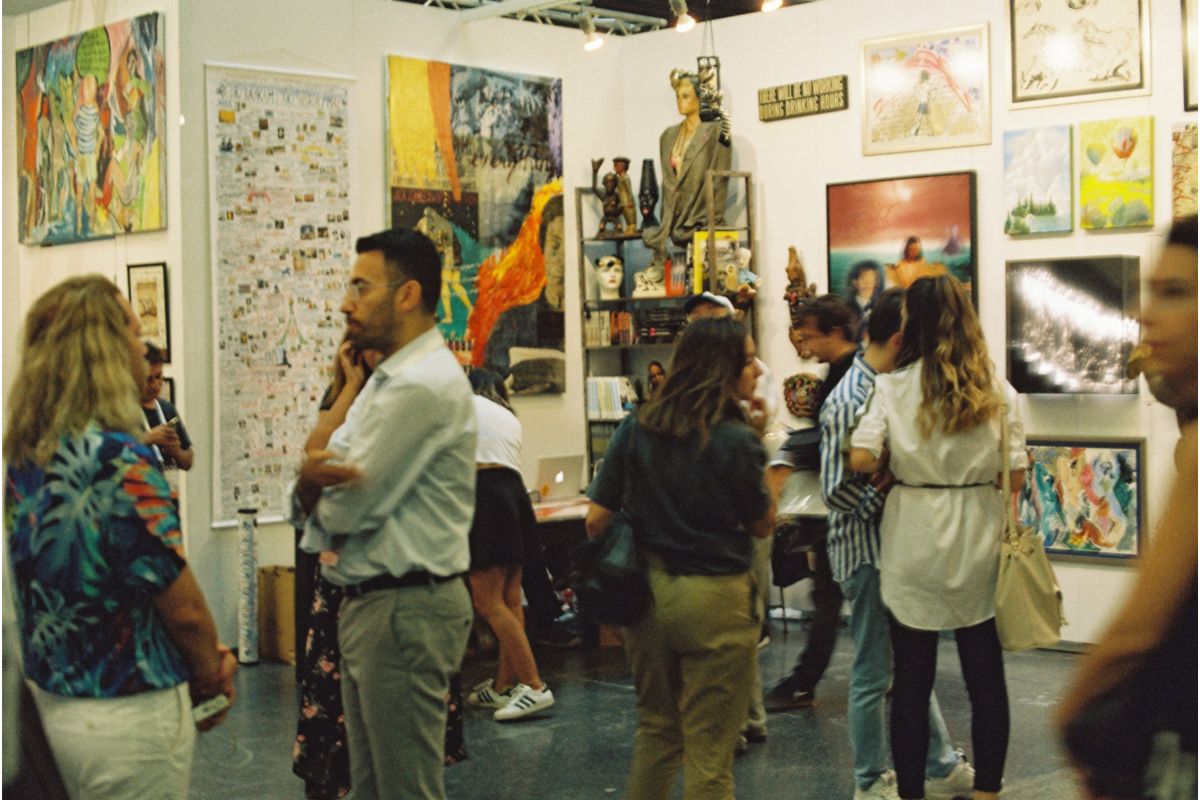
Of course, just because selling art online is becoming more and more popular, that doesn’t mean we should forget about more traditional avenues for selling your art.
Particularly if you work in a more traditional medium, and you find that the impact of your work doesn’t translate digitally all that well.
With exhibits at art fairs and galleries however, buyers can see the textures and smaller details up close and put a face to the art.
Selling art in physical spaces is a great way to build connections with buyers and fans of your art, and you can even use in-person events to encourage buyers to seek out your art online.
When selling your art in a physical venue, it’s important to keep the following in mind:
- Collaborate with a gallery to exhibit your art and create buzz.
- Research local art fairs, events, and markets, and establish a semi-permanent or one-time booth.
- Get in touch with art stores, gift stores, or lifestyle retail stores to see if you can set up a pop-up exhibit of your work.
- Make your studio open to the public when you launch your online store or website, and establish consistent open-studio hours to build a relationship with buyers and fans who can gain an insight into your artistic process.
- Consign or ‘lend’ work to small businesses like restaurants or cafés to get your art out there.
Many artists dabble with pop-ups as a way to build their reputations and get their art out there, and having an in-person element to the selling of your art is crucial if you’re selling original work.
Still, technological advancements in AR and 3D for online stores and the boom in digital experiences may be a sign of big changes in the world of art.
It’s crucial to keep your eye on customer trends when learning how best to sell your art and develop your business.
How To Work With Galleries
If you’re not really interested in getting involved in the business side of art, or you want a helping hand in your own entrepreneurial pursuits, you can collaborate with galleries who will sell your art on your behalf.
This partnership opens you up to new audiences, including art collectors and buyers. Let’s take a look at a couple of dos and don’ts when working with a gallery:
DO take a look at social media: Take a look at the social media of the gallery you’re considering working with, and be skeptical if a gallery has fewer followers than you, as the whole point of working with a gallery is that they can broaden your reach.
DO your homework: You should only get in touch with galleries whose work aligns with your own artistic style. Also, find out the name of the gallery curator or the gallery director, as a more personal email goes a long way in building a good relationship with galleries.
DON’T contact a gallery through social media: Although you should take a look at a gallery’s social media to see if they’re the right fit for you, tagging a gallery in an Instagram post or sending them a message on Facebook Messenger doesn’t come across as very professional.
DON’T prioritize quantity over quality: A pet peeve among gallery directors is when artists tag them in a social media post along with the directors of dozens of other galleries. Decide on a handful of galleries you’d like to work with, and then reach out to them via email.
Limited Edition vs Open Edition Art
Reproducing your art on mugs, t-shirts, or art prints improves the longevity of a piece of work… or you can create an exclusivity around the work by offering these prints for a limited amount of time.
These two ways of selling your art are called limited edition and open edition.
Open Edition
Open edition is when you print and sell an unlimited number of products. These can be prints or reproductions of an original work.
The advantages of open edition are the continuous profit from just one piece of art, and your art can reach further.
However, this endless availability of your work may lower the value of your work overall.
Limited Edition
Limited edition is when you print a specific number of prints before they sell out completely. These are usually numbered and signed by yourself to give them more authenticity and value.
Limited edition works create an urgency and scarcity around your work, which is a tried and true marketing strategy. This exclusively also allows you to sell your work for a higher price.
However, since the demand is higher than supply, this leads to a secondary market where buyers resell the pieces at an inflated cost.
However, to reduce reselling some online art stores will limit how many prints a customer can buy, to avoid people buying limited edition pieces in bulk which they will then sell on to others for a profit. This ensures that only legitimate buyers and fans of your art are the only people having access to your limited edition work.
How To Set Retail Prices For Your Art
How you sell art online and actually make a profit seems near impossible when you first set out to do this. However, making a living off your art is achievable when you know the value of your art and how to price your work.
Still, this is challenging because – as we all know – art is subjective so doesn’t fit squarely into general pricing strategies.
How To Price Original Art
To run a sustainable business in the long term it needs to be profitable… eventually. In order to achieve this, you will need to price your art as accurately as possible.
If you’re new to selling your art and are just starting to get your name out there, there is an easy formula for pricing your original art.
How much it costs to sell and market your art + costs of material + other expenses + your profit = retail price.
For this formula, it’s beneficial to take into account how much time you spent creating the piece too. Normally, artists tend to undervalue their work and time, especially when they’re starting out.
The only gap in this formula is that art is, of course, subjective and doesn’t necessarily depend on details like labor hours and the cost of materials.
Famous artists can price a piece of work higher even if the creation costs are about the same as the work of an emerging artist.
You should research the market to compare your pricing to artists who produce similar work and at a similar level.
If you are selling your art with an online or physical gallery, the gallery will normally take half of the final selling price. Working with gallerists who have experienced pricing and valuing art to set prices for your work is a smart move.
How To Price Art Prints
To sell art prints there is a more straightforward pricing formula you can follow:
How it costs to print your work + how much it costs to sell and market the piece + additional expenses + your profit = retail price.
Your profit may be scalable depending on whether you sell limited edition or open edition prints. Additional expenses may include app fees, office supplies, professional services, software fees, studio rent, etc.
Knowing the value of your work and where you’re able to compromise are crucial for making confident decisions about pricing your work.
For example, sustainability might be important for you, even if it makes producing your art more costly and therefore expensive to sell.
It’s important to be clear with the customer about these decisions, especially if you price your work particularly high.
View: How to price your art? A guide for artist and photographers
How To Photograph And Scan Your Art
Representing your products accurately and clearly is crucial for your online art store. Since customers cannot physically touch the product, they need to get the best idea possible about what it is they’re spending their money on via detailed and clear photographs.
If you have a poor quality image of your work, or it portrays the work inaccurately, selling your product is going to be difficult.
Customer satisfaction is also an issue, and you’re going to have to deal with unsatisfied customers and returns. So how do you best photograph or scan your art?
How To Photograph Your Art To Sell
Photographing your work is a little more difficult than photographing other products, as a simple light setup may make the colors distorted or you may have an issue with glare.
If you can, you can hire a professional photographer to shoot bigger works, or any art that has glossy elements or 3D elements.
If you’re selling merchandise or other products that feature your artwork, the usual product photography rules apply. You should take clear pictures from a variety of angles, as well as zoomed-in photographs to illustrate detail and texture.
To illustrate the scale of your work, lifestyle photos (i.e. your product in a scene) are excellent for the homepage of your online store and on your social media platforms.
Print-on demand companies often give you mockup images that you can use for your product pages as an addition to photography.
More tips: How to Photograph Your Artwork for Reproduction
How To Scan Your Art To Sell
Scanning 2D works is an effective and affordable alternative to photographing your work. The most cost-efficient way to do that is to scan your work in parts with a desktop scanner and piece it together digitally.
If your work has a high-gloss resin or coating, then this becomes a bit more difficult, but most works that are on paper or canvas are very easy to scan. But for more challenging pieces, you can reach out to printing services and galleries for help.
How To Print Your Art
Knowing how to sell prints of your artwork involves becoming familiar with your printer, whether that’s through a company that takes care of this task for you or with your inkjet printer you have at home.
There are many options for printing your art, you can let a third party handle it or do it yourself.
DIY Printing
You can start selling your art by creating high-quality prints with good paper, ink, and an office printer. If you’re a new artist this is very cost-effective, but as your business grows this will probably become unsustainable.
A lot of artists manage fine with printing, packaging and even delivering their orders, but this becomes too much to do on their own, and gets in the way of actually producing their art.
This method is also normally restricted to selling art prints on paper, but some specialized home printers sometimes also let you print on canvas paper.
Printing Companies
An online or local printing company can cut down your workload considerably and you can even make use of bulk discounts if you’re printing a piece at a high volume.
This can be the most effective way to sell your art online if you have a small portfolio and sell lots of the same piece.
However, you are still responsible for packaging and shipping the prints you sell. These services usually produce high-quality pieces as they have more sophisticated printers.
Some services also deliver to your studio first, rather than going straight to the customer. This is so you can do a last-minute quality assurance check before it reaches your customers. (Read: ASF Prints)
Printing On Demand
Printing on demand is the most flexible, simplest and hands-off option for printing your art, especially if you want to print your work on things like hats or t-shirts.
Print on-demand services are normally integrated with your online store, so when an order is placed, the integration is immediately triggered, and the price is printed and shipped straight to the customer.
This is the ideal option if you’re on a budget, as you don’t have to worry about investing in inventory or equipment.
Print on-demand services are great when your orders are beyond your capacity to print and ship your work.
All you need to do is upload your work and let the on-demand service do the rest! This gives you more of an opportunity to create your art and connect with customers.
Plus, print on-demand products are not just limited to paper prints. You can also have your art printed on things like stickers and phone cases too.
However, before you begin this process, ask for samples from the on-demand service so you can take a look at the quality of the print and the colors. This is particularly important if these items are going to be shipped straight to customers.
See: How Art Storefronts advanced Print-On-Demand service (otherwise known as our Automated Fulfillment service) works to pay photographers immediately while giving them robust shipping options.
How To Package And Ship Your Art
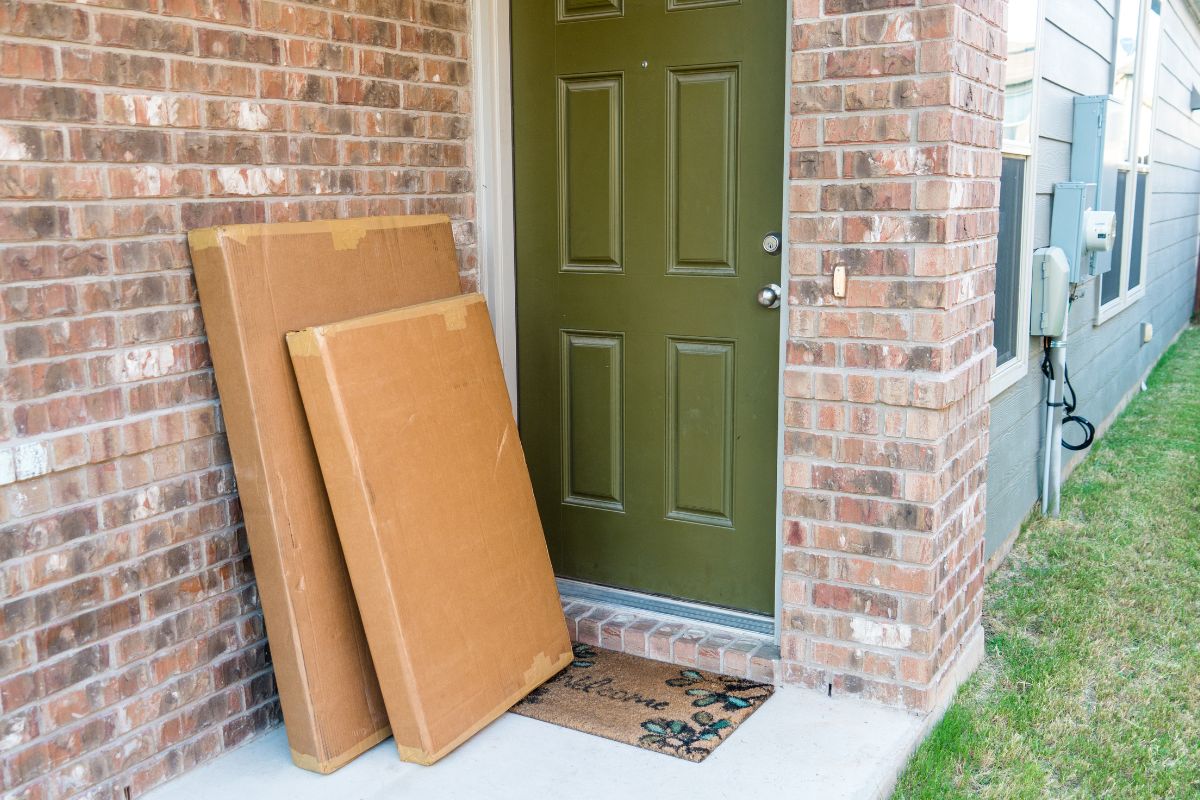
Since art is visual even the tiniest details are important and this includes how your art is packaged and shipped too.
Yes, your art should arrive undamaged and be delivered safely, but your branding should also be reflected in your packaging.
Since art can be delicate, take a look at our below tips to make sure your work gets to your customers safely.
Shipping Your Art Yourself
When shipping original art, canvases or prints yourself, you need to be extra careful when packaging your work. It’s best to ship large posters and prints in cardboard mailing tubes, while smaller prints can be shipped in firm cardboard mailing envelopes.
To protect your prints, you can use glassine – which is a grease and water-resistant paper – or clear cellophane sleeves. Packaging that has your branding on it – such as poly envelopes or tissue paper – can be a treat for customers and boosts your branding.
A lot of ecommerce platforms make use of shipping apps and providers to assist you in discovering the right shipping rates for each package and market. You should decide if you want to offer free shipping.
If you do decide to do this, you should include the shipping cost into the retail price. Or you can change a flat rate to make the shipping process more transparent.
Shipping Large, Expensive Original Art
Canvases and framed works need even more precautions when shipping to customers. Packaging supply stores provide packing and shipping materials such as specialty box sizes and cardboard corners.
When shipping original work to an art collector or gallery, you can make it more cost-effective. Shipping an oversized painting that’s stretched on a canvas can be pretty expensive, but you can compress a canvas, roll it in a tube and then ship it which seriously reduces the freight costs.
Shipping Art Directly
The simplest way to sell art online is to let an on-demand printing service fulfill, print, and ship all orders. They have access to better shipping rates because of relationships with carriers and because they ship items in bulk.
Fine Art Shipping Insurance
When you’re shipping original works having insurance is crucial, as if a package is damaged or lost it cannot be replaced. A lot of basic carriers only provide pretty meager insurance on most packages, and if you sell your art you should consider specific additional coverage costs.
If you’re selling original artwork for a high price, extra measures need to be taken to make sure the work arrives safely. If you’re shipping art that is worth over $1,000 then things become complicated.
We recommend considering a private freight carrier or a company that specializes in handling costs, even though this will be expensive it’s worth it.
Other Sites To Sell Photography
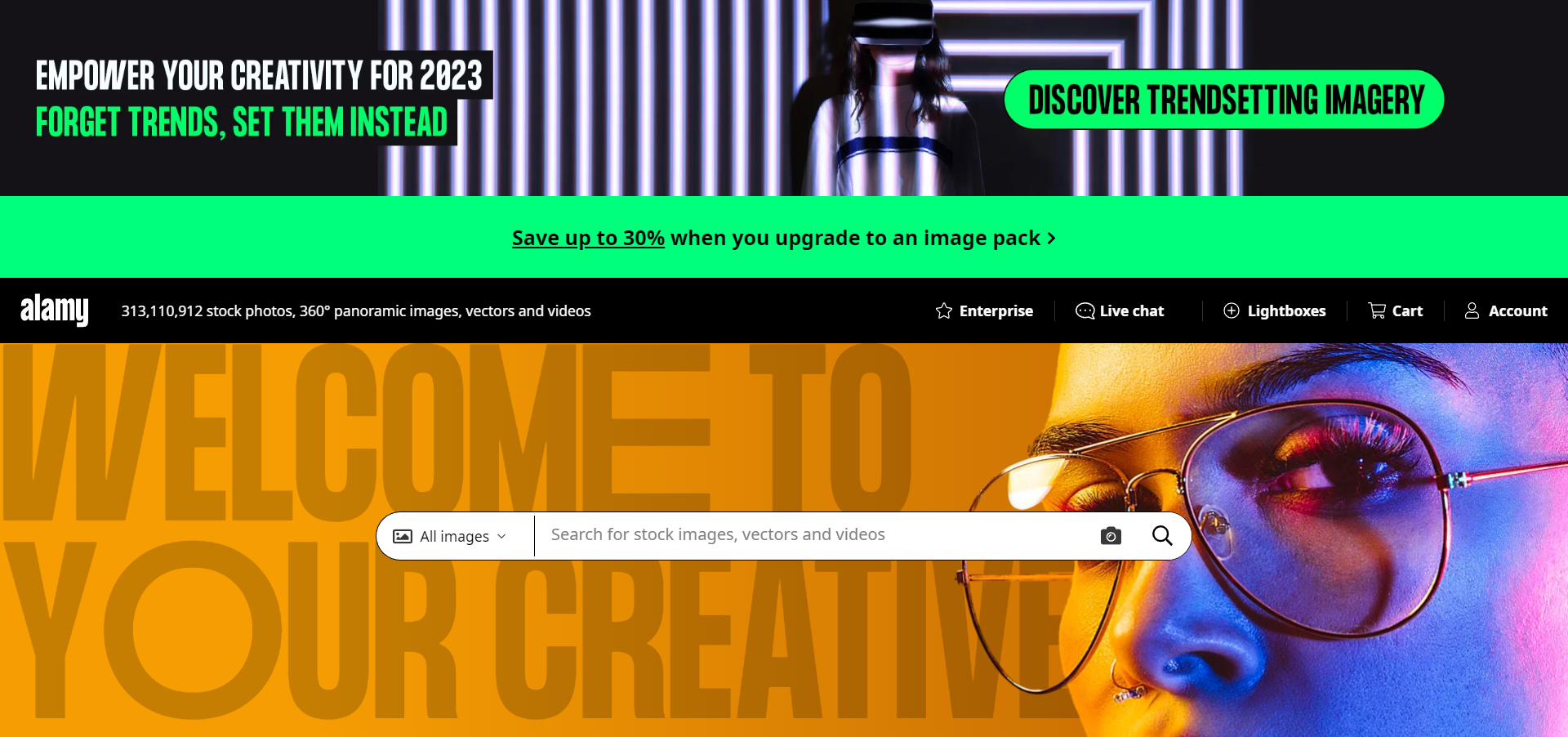
Alamy
Launched in 1999, Alamy is a stock photography website that is based in the UK. It currently has over 60 million stock photos and videos on their site, and this is partly due to the 50% royalty payment on every photograph sold.
Although the commissions are hefty, you don’t have to exclusively sell your photos to Alamy, which makes it a great place for photographers to sell their pieces.
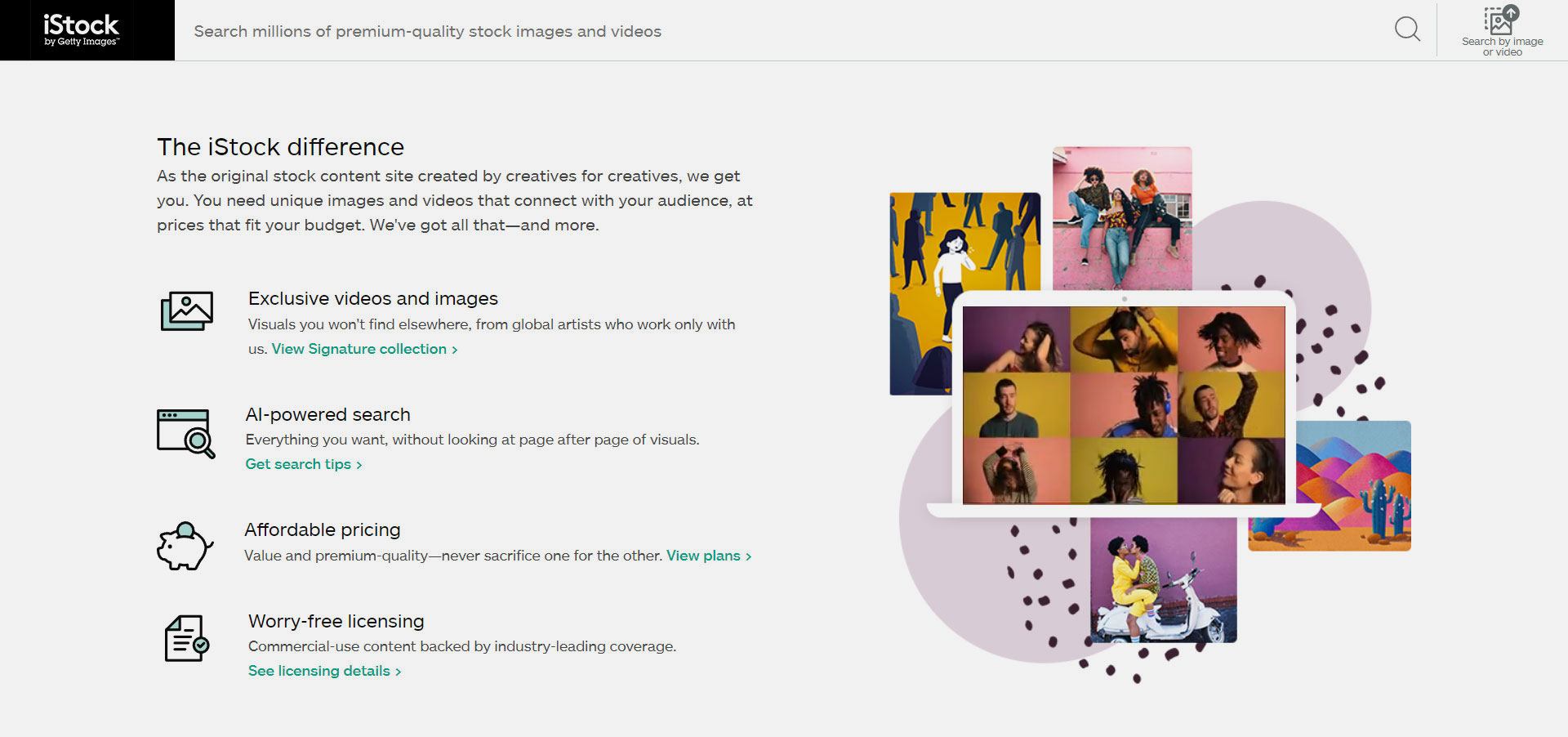
iStock Photo
A microstock branch of Getty Images, iStock Photo is an excellent place to sell stock photos if you’re starting out because it’s a popular site.
They also host popular forums and have resources that give you advice on how to sell photos online. So if you don’t really know where to begin, using iStock Photo can be very beneficial!
Their royalty payments begin at 15% with every download, which can go up to 45% depending on how popular your photos are. If someone buys an image with subscription credits, you only get 15% of royalty payments.

Shutterstock
Shutterstock is home to a staggering nearly 200 million photos and 90 million videos! Since being founded in 2003, Shutterstock has enjoyed a steady growth in sales.
When you upload to the marketplace you can get 30% commission of the sale price of your image.
However, this will be dependent on the size of the image. Still, the copyright to the image is completely yours and you can still sell the images on other platforms.
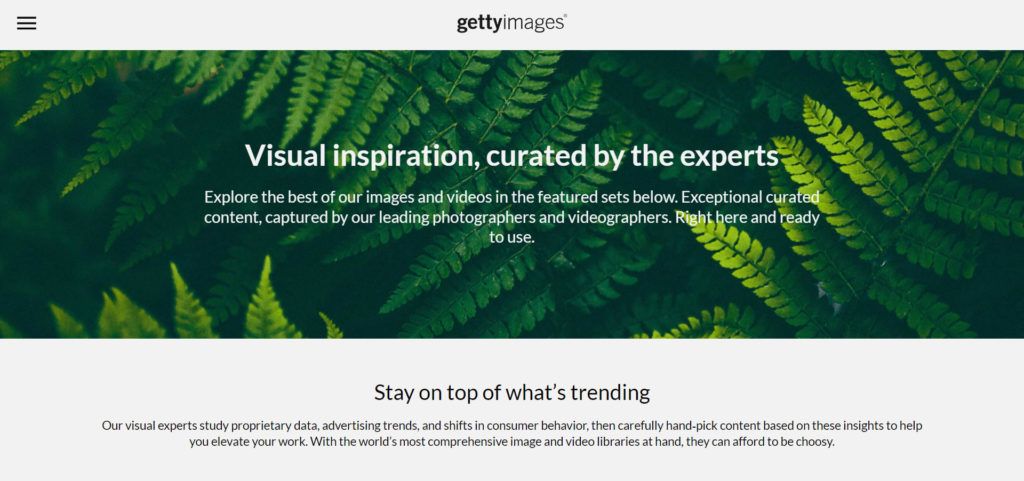
Getty Images
Getty Images is maybe one of the most prestigious places to sell your images. Founded in 1995, Getty Images has become the go-to stock and editorial photography site on the internet.
As we mentioned before, iStock is the microstock photography branch of Getty Images. However, they sell high-end content via Getty Images that usually sells for thousands of dollars.
To buy an image from Getty Images, you will need to purchase a Rights Managed license. This means that you don’t pay for the image, but you have the right to use them on certain platforms whether that be in print or online.
Because of this exclusivity, it can be difficult to get into Getty Images. You need to submit six images to apply to Getty Images. They will then decide if your material is either suitable for Getty Images or iStock.
If you’re accepted, you can earn up to 20% in commission for your images. Photographs on Getty Images can sell for hundreds of dollars, so you can make quite a big profit!
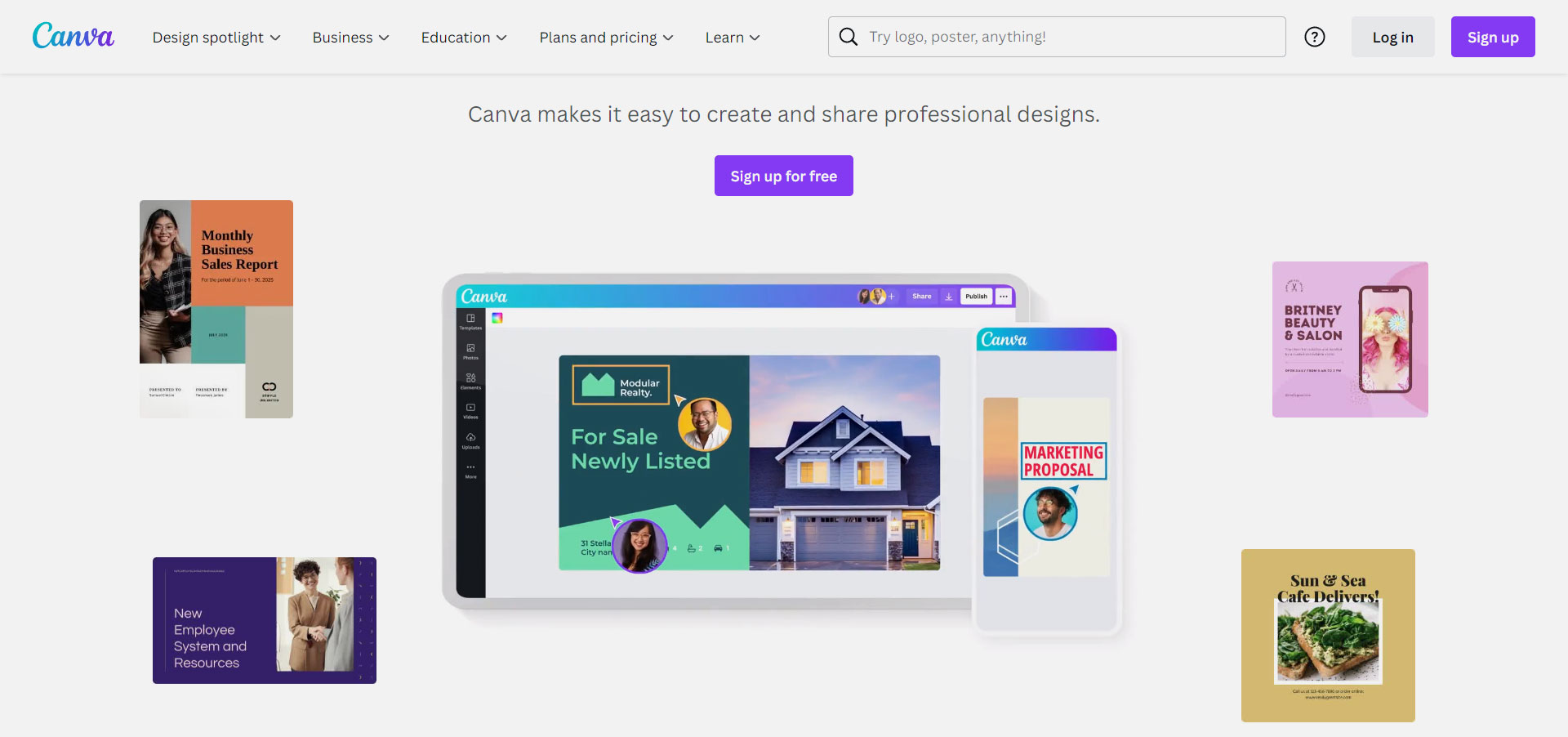
Canva
Canva is one of the most user-friendly editing platforms available, with drag-and-drop features that let pretty much anyone create posters and Instagram Story animations.
Many of the photos and graphics on Canva are free, but they also have stock photography services available too.
Canva is unique to more traditional stock photography agencies because they make it super simple for customers to buy images. They just have to drag and drop the photos, and click ‘purchase’ to remove their watermark.
The user-friendliness of Canva gives you plenty of opportunities to make money off your images, since there are many people who use Canva over traditional stock photography agencies.
Canva also has millions of users, and their user base just keeps growing. You can apply to Canva and post your stock photos, but Canva also often asks their contributors to shoot custom photographs for them.
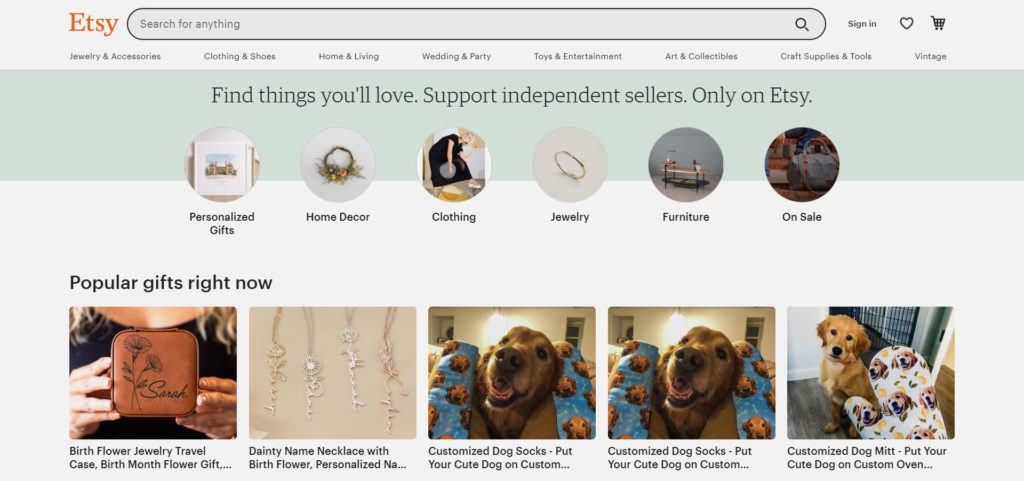
Etsy
Etsy is the internet’s largest marketplace for handmade products. If you’re a photographer, you can sell items as digital downloads as physical prints. Many of the products are also bespoke and unique, which gives the products an air of scarcity.
Etsy also has over 30 million users, and is an excellent place to sell your photos. Etsy is also a great place to build your brand. You can determine the prices for your photographs and even create a page to best show off your photographs!
Etsy makes 20 cents on every product you upload and 3.5% of the sale price, so selling items can be challenging.
Still, they provide a useful guide that tells you all about how to brand and market yourself. They also give you advice on how to sell your photos, price your items, and how to succeed on Etsy.
Disclaimer: Marketplace sites come and go every year, and most of them are continually altering their algorithms to determine which artists are easily discoverable (and which aren’t). Learn the differences between marketplaces and Art Storefronts and how building your own online art gallery is the best way to sell your art.
What Is A Good Price To Sell Photos Online?
All photographers know that finding a way to sell your images is crucial for creating a successful business.
Creating a business taking portraits or photographing events like weddings is of course fun, but if you’re not confident enough to do that, then you can sell your photos on the web!
There are many options available to photographers to sell their photos online. The most popular options are stock photo agencies, and there are also some websites where you can sell your images straight to customers, or even sell them as artwork.
Benefits Of Stock Photography Websites
Stock photography websites are essential for photographers for two reasons. Firstly, they do all the hard work of selling your pieces for you. Once the photos are uploaded, you just need to sit back and count your cash!
As well as helping you sell your photos online, stock photography websites provide you with insight on current trends. They give you tips and ideas on what images have the best chance of making you the most money.
The drawback with these websites is that they have a lot of content on offer, with more images being uploaded every minute. This means your work will have a lot of competition to deal with.
Another downside is that to upload images to stock photo websites, you need to spend a lot of time editing them. This is because these websites have strict rules for selling their photos regarding the quality of the photograph, and information that has to go with it.
How To Build Your Brand
Typically, your brand will grow and develop as your art does. Your medium and style will distinguish you as an artist and naturally draw in buyers and fans.
Still, there are a lot of decisions that you need to make when considering yourself as an entrepreneur as well as an artist, which you need to do to find success.
Buying art is personal, and there is often a lot of emotion behind a purchase.
Therefore, your brand could play a big part in someone’s decision to buy your work. Other business assets like website design and packaging should align with the aesthetic of your artwork.
When building your brand, consider the following:
- Do you use a brand name, your own name, or a pseudonym to create and sell your art?
- How do you want to approach telling the story of your brand?
- How autobiographical will your brand story be?
- Do you have a cause, mission statement or values that you want your brand to communicate?
- What visual direction do you want to take your brand?
- What do you want the tone of your communication to be?
What assets do you need for your branding to be successful? If you don’t have the design skills, or you can’t afford to hire a graphic designer, there are free tools available that are easy to use so you can design your own logo.
The answers to these questions will help you determine principles for your brand that will guide you on how to design your marketing materials, your website, etc. If your business scales up, these principles will also help with brand consistency as you delegate tasks to your staff or collaborators.
Many artists develop a fan base that centers around their online presence or personal brands that are closely linked to their art.
If you collaborate with other artists, you don’t have to stick to the messaging of your own brand, but actively listen to the branding needs of who you’re collaborating with and be proactive.
Copyright Protection And Plagiarism Issues When Selling Your Art
While many artists have taken on copycats – such as big fashion brands who rip off artists’ original designs – plagiarism and copycats are a sad reality of combining art and business.
If you have the resources to take legal action then you definitely should.
Many artists are comfortable in the knowledge that copying others’ work is not sustainable, so eventually the talented artists will come out the winner. Still, this doesn’t mean you should just sit back and let people copy your work and make money off your art.
Galleries who represent many artists and sell their art online, copycat websites are a constant issue. These copycat websites essentially bootleg art, and while it is a sad reality of the business, galleries will do their best to ensure your work is not plagiarized and take action when it is.
As we have already mentioned though, galleries and artists have legal recourse and can seek legal advice from a copyright lawyer who is experienced in intellectual property and copyright law before their copyright is infringed.
Final Thoughts
For a lot of upcoming artists, the greatest way to sell their art online is just to make a small start, without worrying about resources or space.
Many artists start their business from their homes, whether that be their basements, bedrooms, or kitchen. You have to start somewhere!
When you first start out, you will basically be a one-man operation. You will be in charge of marketing, web design, packaging, shipping, and customer service, as well as creating the art!
And while this is very stressful and it’s an amazing feeling when you can scale up your business, it also gives you an intimate knowledge of your business which you can share with staff when your business is viable enough to do that.
You may not have got into this industry to be an entrepreneur, but to make this a profitable career, the sooner you can think of yourself as an entrepreneur the better. This will be a learning curve, but it will ultimately help you to develop and scale your business.
You will eventually be able to automate aspects of your business and delegate them to staff, so you can just focus on what you do best… create art!
But having an in-depth knowledge of art and business is what makes for a successful art brand.
Sell More Art Online
If we can't teach you, no one can!


